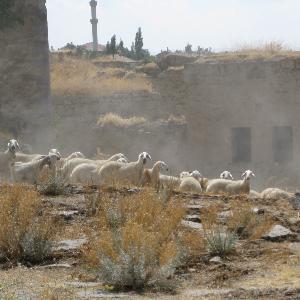Modern Eurasian sheep predominantly belong to only two so-called genetic matrilineages inherited through the ewes. Previous research thereby assumed that genetic diversity must already have decreased rapidly in the early stages of domestication of wild sheep. Our study of a series of complete mitogenomes from the early domestication site Asıklı Höyük in central Anatolia, which was inhabited between 10,300 and 9,300 years ago, disproves this assumption: despite a millennium of human interference with the keeping and breeding of sheep, mitogenomic diversity remained invariably high, with five matrilineages being evidenced including one previously unknown lineage. The persistently high diversity of matrilineages observed during the 1,000 years of sheep farming was unexpected for the researchers.
We can now assume that this development is due to a so-called "bottleneck" that took place later in the Neolithic period.Joris Peters

Today's descendants of the first domestic sheep of Central Anatolia. Even today, agriculture in this region is still largely based on large flocks of sheep. | © Nadja Pöllath (SNSB-SPM)
"In Aşıklı Höyük, there were both sheep raised in captivity and wild sheep hunted by the inhabitants of the site. We assume that occasionally managed flocks were supplemented by native wild sheep when necessary, e.g. to compensate for losses due to disease or stress in captivity”, says Professor Joris Peters, State Collection of Paleoanatomy (SNSB-SPM) and Institute of Paleoanatomy at LMU, interpreting the results of the study, recently published in the journal Science Advances. One should also consider that people exchanged sheep over wider areas. “A possible parallel to such practice can be found in the import of cereal crops to Central Anatolia, which are native to Southeast Anatolia."
The different matrilineages are similar to the branches of a family tree. Individuals belonging to a particular lineage show comparably little variation in their mitochondrial genomes, because descending from a common female ancestor. Today, lineage B predominates among sheep in Europe and lineage A in East Asia. Consequently, mitogenomic diversity decreased later in the domestication process or at the time when sheep farming spread beyond the original domestication region during the Neolithic.
To address this, the international team of researchers led by Peters investigated matrilineal affiliation and phylogenetic relationships of 629 modern and ancient sheep across Eurasia. Ivica Medugorac, LMU Professor of Animal Population Genomics, and Professor Dan Bradley from Trinity College in Dublin were also part of the study.
Chance and necessity
News
Long process of taming
Read moreComparison of Aşıklı Höyük's results with ancient DNA signatures in archaeological sheep bones from later settlements in Anatolia and surrounding regions as well as in Europe and Middle Asia clearly illustrates that mitogenomic diversity decreased significantly in the ninth millennium before present. One result of this is the aforementioned dominance of matrilineage B in Europe. "We can now assume that this development is due to a so-called "bottleneck" that took place later in the Neolithic period, when sheep farming spread beyond the natural distribution of wild sheep following the early domestication of the species”, Peters says. This bottleneck likely relates to so-called founder effects, in which smaller flocks were consecutively removed from an already greatly reduced sheep population in the course of the spread of small animal husbandry on the way to Europe.
Particularly fascinating for the researchers are the insights gained through the integration of genetic and archaeological datasets. Together with the numerous other mosaic pieces that zooarchaeologists, archaeologists and geneticists have collected over decades, an increasingly coherent picture of human cultural adaptations since the last Ice Age now emerges. “Studies like these show that animal domestication is not to be understood in terms of a cross-generational plan, but rather as a process of chance and necessity that has significantly shaped our recent cultural history and accompanies us to this day," explains Ivica Medugorac.
Edson Sandoval-Castellanos et al.: Ancient mitogenomes from Pre-Pottery Neolithic Central Anatolia and the effects of a Late Neolithic bottleneck in sheep (Ovis aries). Science Advances 2024.









